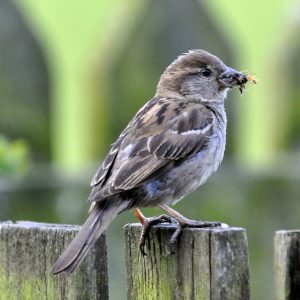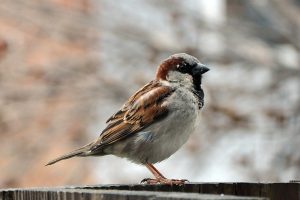
Flycatchers, bee-eaters, swallows and swifts conjure up images of birds flitting through the air in quest of some sort of arthropod. We mostly don’t think about the tiny prey item that gets engulfed by the snapping avian jaws. So let’s give them some thought. Birds eat an estimated 500 million tons of insects each year. That’s 20 quadrillion individual insects! If we could harness the energy of this many insects, we could light up New York for a year.

In the 18th century, up until after WWI, the House Sparrow was considered an agricultural pest and sparrow clubs cropped up to kill the creatures. In both the UK and later in the US after House Sparrows were introduced and became abundant, bounties were paid to destroy the birds. From an introduction of 100 pairs in New York City in 1889, the estimated population in 1943 was 150,000,000 – abstracted from the interesting history of the House Sparrow.
In the 1950s, the UK sparrow population was about 9.5 million; by the 1990s the population had dropped to 3.6 million. The population keeps declining. For years it was a mystery. Habitat destruction, global warming, pollution, cats, power lines, and unusual weather all share the blame, but it appears that a major factor was a decline in insects.
Sparrow nestlings were dying because the parents could not find enough food to feed them. (Seeds do not provide enough protein for growing chicks; they need a diet of 70 percent animal matter.) The newspaper The Independent offered a £5,000 prize for explaining this mystery. Almost nine years later a group of scientists from the Royal Society for the Protection of Birds discovered the ornithological starvation.
The Guardian reported recently on what it called the “insect apocalypse,” noting that a study of German nature reserves revealed a 75 percent decline in flying insects over 25 years. In Britain, 30 to 60 percent of insect species were found to have shrinking ranges; overall insect species had declined by an average of 45 percent. Many birds that depend on insects have a harder time surviving and breeding. In France, the partridge population dropped by 80 percent; nightingale numbers dropped by half, and turtledoves by 80 percent. Overall, half of all farmland birds in Europe disappeared in 30 years.
The Independent also reports that French ornithologists charted a steep decline in Paris and other French cities and even sharper fall in urban populations in Germany, the Czech Republic, Belgium, the Netherlands, Italy and Finland.
According to the Washington Post, the global population of insects is in crisis. “Huge numbers of bugs have been lost in a pristine national forest in Puerto Rico, the study found, and the forest’s insect-eating animals have gone missing, too. In 2014, an international team of biologists estimated that, in the past 35 years, the abundance of invertebrates such as beetles and bees had decreased by 45 percent.”